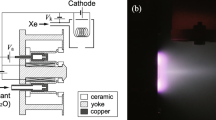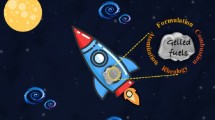Abstract
At present, the study of solid-propellant ignition is of particular interest owing to the adoption of hybrid motors [1–3]. The status of experimental and theoretical research in this field can be evaluated on the basis of the rather extensive survey of American papers in [2]. It is noteworthy that a common deficiency in available references is the absence of exact ignition criteria; in most cases the propellant is assumed to have ignited when its surface temperature reaches a prescribed level (gasification temperature), or when the rate at which the temperature increases with time at the propellant surface is sufficiently high. Exact criteria for this rate, however, are not given. In this article, we present ignition criteria for solid propellants and these are based on a diffusion-burning model. It is shown that for a diffusion flame to exist above the propellant surface, two conditions must be satisfied simultaneously: 1) the propellant surface temperature must equal the gasification temperature for that propellant and 2) the temperature gradient at the surface must be smaller than some value which depends on the kinetics of the chemical reaction in the diffusion flame and on the rate of oxidizer input to the propellant surface during burning.
Two ignition techniques are examined as examples: ignition by hot gases or radiant heat flow and ignition by means of an active film which reacts with a cold oxidizer; the film is applied to the propellant surface prior to ignition.
Similar content being viewed by others
References
M. Barrère, “L'allumage des fusees hybrides,” La Rechèrche Aérospatiale, No. 104.
E. W. Price, H. H. Bradley Jr., G. L. Dehority, and M. M. Ibiricu, “Theory of ignition of solid propellants,” AIAA Journal, vol. 4, no. 7, 1966.
R. Anderson, R. S. Brown, G. T. Thompson, and R. W. Ebeling, “Theory of hypergolic ignition of solid propellants,” AIAA Preprint 63–514, 1963.
G. A. Marxman, C. E. Wooldridge, and R. J. Muzzy, “Fundamentals of hybrid boundary-layer combustion,” in: Heterogeneous Combustion, New York-London, Acad. Press, pp. 485–522, 1964.
D. A. Frank-Kamenesskii, Diffusion and Heat Transfer in Chemical Kinetics [in Russian], Izd-vo AN SSSR, 1967.
Ya. B. Zel'dovich, “Burning of unmixed gases,” Zh. Tekhn. fiz., vol. 19, no. 9, 1949.
Ya. B. Zel'dovich, “Theory of the burning of powders and explosives,” ZhETF, vol. 12, no. 11–12, 1942.
D. B. Spalding, “A theory of the extinction of diffusion flames,” J. Fuel, vol. 3, no. 3, pp. 255–273, 1954.
D. B. Spalding, “Theory of mixing and kinetics of chemical reactions in the diffusion flame of opposite jets,” collection: Voprosy raketnoi tekhniki [Russian translation], no. 6, 1961.
V. B. Librovich, “Ignition of powders and explosives,” PMTF, no. 6, 1963.
A. E. Averson, V. V. Barzykin, and A. G. Merzhanov, “Laws governing the ignition of condensed explosive systems for ideal heat transfer at the surface with allowance for burnout,” Inzh. -fiz. zh, [Journal of Engineering Physics], vol. 9, no. 2, 1965.
V. N. Vilyunov and O. V. Sidonskii, “Ignition of condensed systems by radiant energy,” Fizika goreniya i vzryva [Combustion, Explosion, and Shock Waves], no. 4, 1965.
Author information
Authors and Affiliations
Rights and permissions
About this article
Cite this article
Librovich, V.B. Ignition of solid propellants. J Appl Mech Tech Phys 9, 156–160 (1968). https://doi.org/10.1007/BF00913171
Issue Date:
DOI: https://doi.org/10.1007/BF00913171




